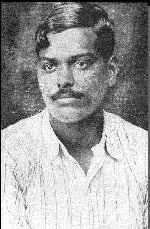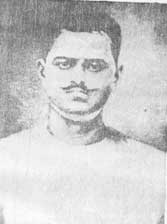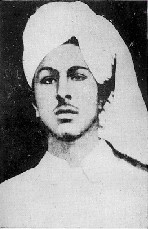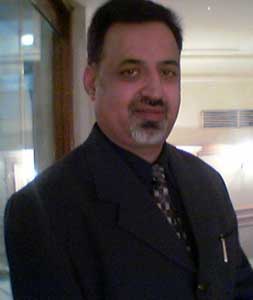 |
 |
| Back to Home |
|
|
||||||
|
At the same time, in the District Jail at Faizabad, Uttar Pradesh, officials were getting ready to put an end to the life of a man. He was a revolutionary. Officials, both high and low, were busy. The Chief Jailer carefully inspected the rope, the sandbags and other things necessary for his execution . He was fully satisfied with the arrangements. Then he called out to his subordinate, "Bring the convict here". The official went with ten soldiers. The door of the cell of the man who was to die opened with a loud, harsh sound. That was the last time the door opened for this man.The brave patriot was waiting for this call. He asked cheerfully, "Is everything ready?" The Lion Among Men The hero in chains walked upright and with resolve between soldiers who led him to the hangman’s post. Those who were there forgot their positions and prestige and gazed at him with wonder and admiration. Once at the foot of the steps leading to the post, he covered them in two leaps and stood facing the post. When they removed the chains, he put forward his arms, drew the rope towards him and kissed it. He said, "My hands are not soiled with the murder of man. The charge against me is false. God will give me justice".Then he prayed in clear, ringing tones "La ilahi il Allah, Mohammed Ur Rasool Allah".The hangman’s noose came round his neck. The moment the lever was pressed, the plank on which he stood moved quickly and he went down into the pit below. He joined the band of the brave immortal heroes of the land. This hero was Ashfaqulla Khan, the immortal revolutionary. Born in the early part of the twentieth century in Shahjahanpur, Uttar Pradesh, Ashfaqulla was the son of Shafiqulla Khan. In 1921 the clouds of the non-cooperation movement were gathering all over India. Mahatma Gandhi had called on Indians not to pay taxes to the Government or cooperate with the British. This had kindled the fire of freedom in the hearts of all Indians. But at a place called Chauri Chaura people indulged in violence and set ablaze a police station resulting in the death of some policemen. Gandhi became sad on hearing this. It pained him much. So he called off the non-cooperation movement in February, 1922. The youth of the country were greatly disappointed and dejected on account of this. Ashfaqulla was one such
dejected youth. The country should become free as early as possible – this
was his yearning and so he joined the revolutionaries. It was then that
he decided to win the friendship of Ramaprasad, the revolutionary of Shahjahanpur.
Ashfaq had one great difficulty in winning the friendship of Ramaprasad. He was a member of the Arya Samaj. He was eager to explain the greatness of the Hindu religion to those belonging to other faiths. He was eager to take back to the Hindu fold those who wished to return. He had almost taken a vow to do this. Ashfaq was a devout Muslim. But his religion did not come in the way of his attempt to win the friendship of Ramaprasad. Though initially Ashfaq met with some resistance from Ramprasad, eventually his relentless pursuit to strike up a friendship with Bismil bore fruit and they became friends. They ate and lived the revolutionary lives together. In the end both became martyrs on the same day but in different jails. The young revolutionaries wanted to make use of revolver, bombs and other weapons to fight the British. Kashi (Varanasi) was the centre of their activities. They formed the Hindustan Republican Association. Their main objective was to win freedom for the country through armed revolution. This Association published a manifesto called ‘Krantikari’ in 1925, spelling out its aims and objectives. The manifesto said it was wrong for one man to become rich by making another man work hard; it was also wrong for one man to be the master of another. The Association wanted to put an end to such things. Ramaprasad became the chief organiser of the Shahjahnpur wing of the Association. To meet their financial needs Ramaprasad and his assosiates looted some villages. Ashfaq took part in these activities with his brother’s licensed rifle.But the money they got by this means was not enough for their activities. The idea of the Kakori train robbery was conceived in the mind of Ramaprasad while travelling by train from Shahjahanpur to Lucknow. At every station he noticed moneybags being taken into the guard’s van and being dropped into an iron safe. At Lucknow, he observed that there were no special security arrangements. He ran up and noted down the time and number of the train from the time table. He calculated that the money would amount to at least ten thousand rupees. He decided not to miss this chance. This was the beginning of the famous train dacoity at Kakori. At a meeting with revolutionaries from Kashi, Kanpur, Lucknow and Agra, Ramaprasad explained his plans to them . He said, "If we loot the money belonging to the Government, we will get enough for our activities. Moreover, we will not have to harm our own people for money. The task is difficult. It needs to be done with great care. But our efforts will bring excellent rewards. The government also will come to know that the revolutionaries do not mealy talk but act".The members liked his idea. Ashfaq listened silently. From the day he had heard it from Ramaprasad, he had thought about it thoroughly. So he got up and said, "Friends, I consider it a hasty step. It may be a good plan in some ways. But let us think of our strength and the strength of the Government. In an ordinary dacoity, much money is not involved. Besides, the Government will treat it as one of the many usual occurrences. So we shall have to face only what the police normally does in such cases. It will be a different tale when he meddles with money belonging to Government. The entire government machinery will be used to trace and crush us. In my opinion we cannot escape detection and punishment. Our party is not strong enough. Let us drop this plan". But the revolutionaries were caught up in a flood of enthusiasm; they were not prepared to listen to sense. After debating the plan for a long time they decided to go ahead and entrusted the task to Ramaprasad. At the outset he sounded a word of caution. He said, "Friends, we should not fire at any one unless they fire at us. As far as possible let us do this deed without bloodshed". The meeting broke up. Kakori Train Robbery
He had done the first part of his duty in the Kakori plot that day. The guard got down to find out in which compartment the chain had been pulled and why. Two revolutionaries fell on him and made him lie down on his face. Two others pushed the driver from the engine to the ground and stood guard over him. One revolutionary stood at each end of the train and both fired shots with their pistols. In the meantime they shouted, "Travellers, do not be afraid. We are revolutionaries fighting for freedom. Your lives, money and honour are safe. But take care not to peep out of the train". Four young men entered the guard’s van. They managed to push the box to the ground. It had a strong lock. There was an opening on the top; through this opening they could drop moneybags into it. But nothing could be taken out of it.The revolutionaries started dealing blows with hammers to break it open. Ashfaq was the strongest of the group and ran towards the box. He dealt blows after blows on the opening of the box to widen it. Suddenly they heard the sound of a train coming from Lucknow. Ramaprasad was frightened for a moment. He trembled at the thought of the moving train colliding with the train they had stopped. All eyes were on Ramaprasad. He ordered, "Stop firing. Turn down the pistols. Do not strike the box. Ashfaq, wait a little". The few minutes were like an age. The fast moving train passed by on the other track. The slit in the box was widened and the moneybags were taken out. During this time all passengers remained quiet including the British officers thinking that a big gang of dacoits had attacked the train. The safe lay open. They were busy taking out the moneybags bundling them in rugs. Some of them walked towards Lucknow with the bundles on their head. Just ten young men had done this difficult job because of their courage, discipline and patience, leadership and, above all, love for the country. They had written a memorable chapter in the history of India’s fight for freedom. These revolutionaries were Ramaprasad Bismil, Rajendra Lahiri, Thakur Roshan Singh, Sachindra Bakshi, Chandra Sekhar Azad, Keshab Chakravarty, Banwari Lal, Mukundi Lal, Manmath Nath Gupta and Ashfaqulla Khan.
A month passed after the Kakori dacoity, and yet no one was arrested. But the Government had spread a big net. On the morning of September 26, 1925 Ramaprasad was arrested. Before the police could arrest Ashfaq, he had escaped from his home and hid in a sugarcane field half a mile from his home. The police grew tired of searching for Ashfaq. All except Ashfaq had been taken into custody. He managed to reach Kashi after a difficult journey and met a few friends in the Benares University. They advised him to live quietly at least for some time. With the help of these friends he went to Bihar. He got a job as a clerk in an engineering firm at Daltonganj in Palamau district. He worked in the firm for about ten months. This long and forced rest became tiresome for him. So he went to Delhi to find out how he could go abroad and began making preparations. He met a Pathan friend from Shahjahanpur. They had been classmates at school. He was happy to meet Ashfaq after a long time. He took Ashfaq to his room and ordered a nice meal for him. They went on talking about old times till 11 o’ clock at night. Then Ashfaq went back to his room. The next morning Ashfaq was sound asleep. Suddenly there was a loud knock. Ashfaq was still sleepy-eyed as he opened the door. And at once he fell into the hands of the police. Friendship, duty and even the feeling of belonging to the same place – none of these could check the Pathan’s greed for money. The Pathan had fed him, talked to him in a very friendly way and then had handed Ashfaq to the police. The police wanted to use Ashfaq to suit their plans; they tried very hard to do so. An army officer, Tasadruk Khan, was in the police department and had rendered useful service to the British as their agent in Arabia during the First World War. He met Ashfaq in prison and tried to make him agree to give evidence against his former friends. But Ashfaq did not like his advice. The police charge -sheeted him in the court. By this time the Kakori case had progressed much; the case against Ashfaq was combined with it. A committee had been formed to defend the accused in the main case. Motilal Nehru was the chairman. There were eminent men like Jawaharlal, Sriprakasha, Acharya Narendra Dev, Govind Ballabh Pant and Chandra Bhanu Gupta on the committee. Life in prison had made Ashfaq very pious. He said his prayers regularly and during Ramzan fasted very strictly. The main case and the complementary case relating to the Kakori train robbery came to an end. The Court of Justice under the British rule gave its judgement. Ramaprasad Bismil, Ashfaqulla Khan, Rajendra Lahiri and Roshan Singh were to be put to death; the others were given life sentences. The whole country protested against the death sentences. Members of the Central Legislature petitioned the Viceroy to reduce their death sentences into life sentences. Appeals were sent to the Privy council, the highest court in those days. But British imperialism was thirsting for the blood of the Indian revolutionaries. The four revolutionaries sentenced to death died with a smile on their lips and a prayer that they be born again in India so that they could fight again for the country’s freedom. And so they became martyrs. Ashfaq and Ramaprasad were poets just as they were revolutionaries. Ashfaq had composed poems mostly in Urdu and a few in Hindi. His pen names were Varasi and Hazarat. Ashfaqulla was an ideal revolutionary. His devotion to the cause he admired made him the foremost among those who gave their lives to win freedom for the country. Love for the motherland, clear thinking, courage, firmness and loyalty were embodied in Ashfaq to the hilt. He deserves to be remembered and cherished by all Indians for his noble qualities. (Shachindra Nath Bakshi b. 25 Dec 1904, Varanasi, Uttar Pradesh - d. was a prominent Indian revolutionary belonging to Hindustan Republican Association (HRA, which after 1928 became the Hindustan Socialist Republican Association or HSRA) that was created to carry out revolutionary activities against the British Empire in India.He participated in Kakori train robbery and was sentenced to life for the same.) (Rajendra Lahiri 1892 - December 17, 1927 also known as Rajendra Nath Lahiri, was a Bengali revolutionary who participated in various revolutionary activities of the Hindustan Socialist Republican Association aimed at ousting the British from India.He was born in village Mohanpur in District Pabna in erstwhile Bengal (now in Bangladesh). His father was Kshitish Mohan Lahiri. Rajendra Lahiri owned a big estate in Varanasi, but was very active in revolutionary and nationalist activities against the British rule. He participated in the Dakshineshwar bomb case and was sentenced to jail. He took part in the famous Kakori train robbery on August 9, 1925. He was arrested and tried, along with several other revolutionaries, in the year-long case. He was found guilty and hanged in the Gonda jail on December 17, 1927.) (Thakur Roshan Singh (20 Dec 1927 Allahabad Uttar Pradesh) was a great Indian revolutionary.He hailed from Shahjahanpur, Uttar Pradesh.He belonged to Hindustan Republican Association (HRA, which after 1928 became the Hindustan Socialist Republican Association or HSRA) that was created to carry out revolutionary activities against the British Empire in India.He participated in Kakori train robbery and was tried and sentenced to death for the same.He was a close associate of Pandit Ram Prasad Bismil, Ashfaqulla Khan, Chandra Shekar Azaad and Shaheed Bhagat Singh.) (Banwari Lal was a prominent Indian revolutionary.He hailed from Shahjahanpur, Uttar Pradesh.He belonged to Hindustan Republican Association (HRA, which after 1928 became the Hindustan Socialist Republican Association or HSRA) that was created to carry out revolutionary activities against the British Empire in India.He participated in Kakori train robbery and was sentenced for two years imprisonment.) (Manmath Nath Gupta (1908-October 2000) was an Indian revolutionary and author of autobiographical, historical and fictional books in Hindi, English and Bengali. He joined the Indian independence movement at the age of 13, and was an active member of the Hindustan Republican Association. He participated in the famous Kakori train robbery in 1925 and was imprisoned till India's independence in 1947. He has written several books on the history of the Indian struggle for independence from a revolutionary's point of view, including They Lived Dangerously - Reminiscences of a Revolutionary. He was also the editor of the Hindi literary magazine Aajkal. Manmath Nath Gupta joined the Indian nationalist movement as early as the age of 13 years. In 1921, he was distributing pamphlets in the Gadolia area of Benares calling for a boycott of the reception of the Prince of Wales by the Maharaja of Banares. When a police officer approached him, he stood his ground instead of running away. During the court proceedings, he told the judge, "I will not cooperate with you." He was jailed for three months. The Kakori train robbery was the turning point in his life. On 9 August 1925, ten revolutionaries including Manmath Nath Gupta stopped a train near Kakori and looted the government treasury traveling in it. He was later arrested and tried for this incident, but being a teenager at that time, was not sentenced to death. He was instead imprisoned for life, and spent some time in the Cellular Jail in Andaman.He was released from imprisonment after India gained independence on August 15, 1947. He became a prolific writer, producing about 120 books in Hindi, English and Bengali. In They Lived Dangerously he narrates the life of revolutionaries and how they saw and reacted to the various events in Indian independence movement. This often presents an alternative point of view to the commonly accepted account. Speaking of the Chauri Chaura incident, he said, "India would have attained independence in 1922 but for Gandhi’s bungling, as many competent writers have said, but there is no doubt that on this occasion Gandhi had failed badly." he became a Communist party of India(CPI)member and was active in political and social movements.He joined the Indian Ministry of Information and Broadcasting and edited the Planning Commission's prestigious publications, including Yojna. He was also the editor of Bal Bharti, a children's magazine, and Aajkal, a Hindi literary magazine.) |
 |
 |
 |
| Back to Home |
 |
Welcome
to
Rajesh Chopra's Guest Book and comments Please |
 |
 |
 |
 |